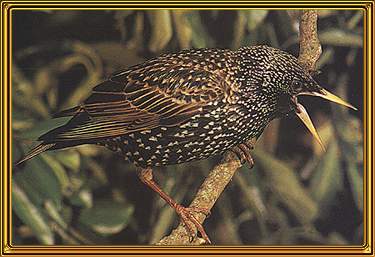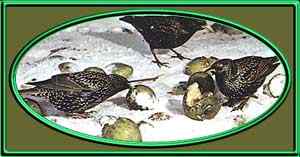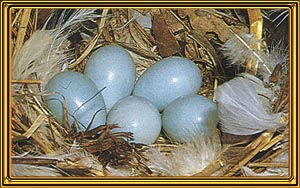
(The Starling)
The Starling is a bird which can adapt to most conditions, from those of the remote Shetlands to central London. The Starling has a glossy blue/black plumage with a purple and green sheen, and the beak is yellow. In winter the bird is speckled with white and buff and the beak is a darker hue. There is little difference between the sexes, but the female is more speckled than the male in winter, and less shiny than the male in summer. Young birds are greyish brown.Starlings run with a curious waddling movement looking for insects and grubs to eat (they are the only birds to look for grubs with their beak open). The favourite food is the larvae of the Crane Fly (leatherjackets). They also eat click beetles and their larvae (wireworms) and other pests. The birds can often be seen amongst cattle feeding on the insects disturbed by the grazing animals. They also pick parasites off the back of sheep. Because of their numbers and also their eating habits, it is not possible to bait or narcotise Starlings, therefore scaring is the only course of action open to pest control, allied with proofing.
When natural food is scarce they can be seen clamouring for bread, fruit and other kitchen scraps, often bullying other birds to ensure that they get more than their fair share. They also damage crops by eating soft fruit, apples and pears, and sprouting cereals.
Biology:
Size: Starlings have a length of 8.5 inches (21.5cm).
Habitat: During spring and summer the birds are more likely to be resident in the countryside adjacent to urban conurbation's, however as the weather turns cooler they move into towns and cities to roost because of the temperatures being higher. As winter approaches, Starlings tend to migrate south and west. Some winter in southern Europe and North Africa. Scandinavian populations winter in the British Isles, hence the increase in population numbers to many millions and the problems that it brings.
Nest: Starlings breed in holes in buildings and trees, and often take over the holes of woodpeckers. The nests are usually made of straw, rootlets, lined with feathers, moss or wool and constructed mostly by the female.
Eggs: The starling usually lays 4-6 eggs which are pale blue. Usually there is only a single brood per season. The eggs are laid in April or May.
Hatch Time: Both male and female share the job of incubation and the eggs usually hatch after after 12-13 days. The young are fed on insects and their larvae, molluscs and worms. The young become independent after about three weeks, after which they start to flock together and start to raid cherry orchards.
Food: Omnivorous, in other words they eat anything if they are desperate.
One thing about the starling is that it is a wonderful mimic of other birds songs as well as the sound of machinery and all sorts, very akin to the Mynah Bird.

